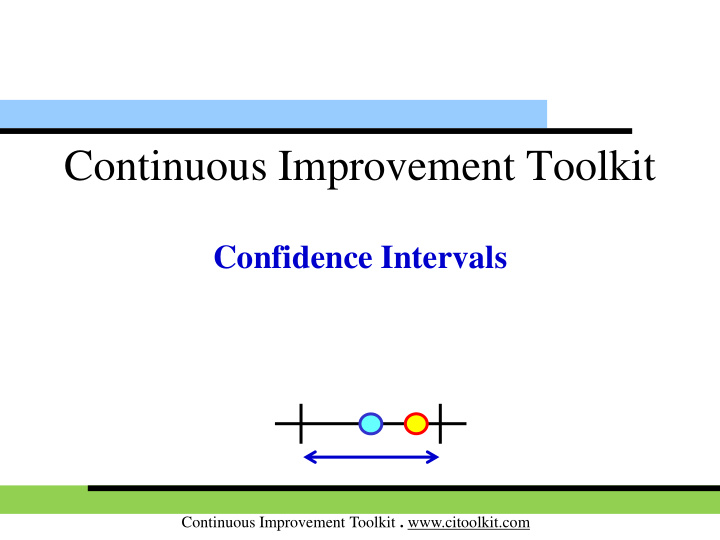



Continuous Improvement Toolkit Confidence Intervals Continuous Improvement Toolkit . www.citoolkit.com
Managing Deciding & Selecting Planning & Project Management* Pros and Cons Risk PDPC Importance-Urgency Mapping RACI Matrix Stakeholders Analysis Break-even Analysis RAID Logs FMEA Cost -Benefit Analysis PEST PERT/CPM Activity Diagram Force Field Analysis Fault Tree Analysis SWOT Voting Project Charter Roadmaps Pugh Matrix Gantt Chart Decision Tree Risk Assessment* TPN Analysis Control Planning PDCA Matrix Diagram Gap Analysis QFD Traffic Light Assessment Kaizen Prioritization Matrix Hoshin Kanri Kano Analysis How-How Diagram KPIs Lean Measures Paired Comparison Tree Diagram** Critical-to Tree Standard work Identifying & Capability Indices OEE Pareto Analysis Cause & Effect Matrix TPM Simulation Implementing RTY MSA Descriptive Statistics Confidence Intervals Understanding Mistake Proofing Solutions*** Cost of Quality Cause & Effect Probability Distributions ANOVA Pull Systems JIT Ergonomics Design of Experiments Reliability Analysis Hypothesis Testing Graphical Analysis Work Balancing Automation Regression Scatter Plot Understanding Bottleneck Analysis Correlation Run Charts Visual Management Performance Chi-Square Test Multi-Vari Charts Flow 5 Whys 5S Control Charts Value Analysis Relations Mapping* Benchmarking Fishbone Diagram SMED Wastes Analysis Sampling TRIZ*** Focus groups Brainstorming Process Redesign Time Value Map Interviews Analogy SCAMPER*** IDEF0 SIPOC Photography Nominal Group Technique Mind Mapping* Value Stream Mapping Check Sheets Attribute Analysis Flow Process Chart Process Mapping Measles Charts Affinity Diagram Surveys Data Visioning Flowcharting Service Blueprints Lateral Thinking Critical Incident Technique Collection Creating Ideas** Designing & Analyzing Processes Observations Continuous Improvement Toolkit . www.citoolkit.com
- Confidence Intervals Point Estimate A point estimate is a simple value that approximates the true value of a population parameter. Examples: Sample mean and standard deviation. The sample mean is a point estimate for the population mean. The sample standard deviation is a point estimate for the true population standard deviation. It is highly unlikely that the sample mean and standard deviation are exactly the same as the true population parameters. Continuous Improvement Toolkit . www.citoolkit.com
- Confidence Intervals To get a better sense of the true population values, we can use Confidence Intervals . Example: • We have a magnet trap to avoid fallen cans during the process. • How confident are we that no fallen cans will cross the trap? Can we be 100 % confident about our results? Continuous Improvement Toolkit . www.citoolkit.com
- Confidence Intervals In our processes we need to know how confident we are with the results coming from our samples. A confidence interval is a range of likely values for a population parameter. Using confidence intervals, we can say that it is likely that the population parameter is somewhere within the range. It is how sure we are that the confidence interval contains the actual population parameter Likely values for value. population parameter Continuous Improvement Toolkit . www.citoolkit.com
- Confidence Intervals Confidence Intervals will help us to know whether our sample is a good representation of the whole population. Confidence Interval Continuous Improvement Toolkit . www.citoolkit.com
- Confidence Intervals The most common confidence level is 95%. Other common confidence levels: 90% & 99%. The high the confidence level, the wider the confidence interval. The higher the process variation the bigger the Confidence Interval. As sample size decreases the α /2 α /2 Confidence Interval gets bigger to cope with the fact that less data has been collected. Confidence Interval Continuous Improvement Toolkit . www.citoolkit.com
- Confidence Intervals Example: Population Mean Suppose we calculate confidence intervals based on 20 different samples. On average, the population mean will be contained within This Confidence Interval does not 19 out of 20 intervals if we use contain the true 95% confidence level. value of the population mean Continuous Improvement Toolkit . www.citoolkit.com
- Confidence Intervals Confidence intervals could be used also to examine differences between the population mean and a target value. Target Value Target Value If the target value is not contained in the interval, the population mean is significantly different from the target value. It could be used also to investigate if the product/process is as good as other products/processes in the market (a standard value). Continuous Improvement Toolkit . www.citoolkit.com
- Confidence Intervals Question: Do we have evidence that the population mean is different from the industry standard? Standard = 3.10 3.11 3.14 Answer: Yes, the confidence interval shows that the range of likely values for the population mean does not include the industry standard of 3.10. Continuous Improvement Toolkit . www.citoolkit.com
- Confidence Intervals Mathematical Equation for a Confidence Interval: Confidence = Sample Sample Sigma ‘t’ +/- n Interval average • The sample average and the sample Sigma are the best estimate at this point. • The value of ‘t’ is taken from a statistical table similar to the Z-table. • n is the sample size. Continuous Improvement Toolkit . www.citoolkit.com
- Confidence Intervals Further Information: Confidence Intervals are used to provide a range within which the true process statistic is likely to be. They allow us to answer questions like: • How confident that the collected sample is a good representation of the population. • Is there is a chance that the process is producing an average thickness of 43.5mm. • Do the random selected 2000 surveyed voters provide a precise prediction of the actual result of the election (Confidence intervals for proportions). Continuous Improvement Toolkit . www.citoolkit.com
Recommend
More recommend